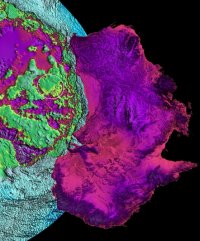
Not every scientist is convinced that this is a crater but Geophysicist Dr. Ralph von Frese of Ohio State University thinks this is the remains of a 48 kilometre wide meteorite that wiped out most of life on Earth. This was at the end of the Permian (called the Great Dying) 250 million years ago when 90 per cent of marine life and 80 per cent of life on land were wiped out.
The circular land features are in the Wilkes Land region of East Antarctica, south of Australia. The crater would be more than twice the size of the Chicxulub crater believed to have wiped out the dinosaurs. von Frese believes its location suggests it is older than 100 million years, the date at which Australia drifted northwards from Gondwana.
The faint yellow circle is a 320 kilometre wide plug of dense material which is a feature of impact craters. von Frese expects this to be mantle material that was sucked up as the meteorite rebounded from the Earth's surface.
The image above shows Australia fitting together with the Antarctic coastline and the concentric rings or shock waves around the crater. Von Frese says this suggests that the ocean between Antarctica and Australia opened after the crater was formed. He thinks the impact could have triggered the process that culminated in the break up of Gondwana 100 or so million years later. This was the creation of the tectonic rift that pushed Australia northward.
Dr. Peter Morgan of the University of Canberra trained in gravity analysis at Ohio State University and says he has ground-based gravity and radar measurements of the same area. He is now processing the data to see if it supports the theory. But before the structure can be linked to the Permian extinction, it has to be dated and it's almost 2.5 kilometres beneath the ice.
While we're still down in Antarctica. Belgium will build the first polar station powered solely by renewable sources of energy - solar and wind. The base will be for studying climate change and will cost $10.8 million. Australian Government please take note and try converting our base down there. Some of that 10 billion earmarked for ID cards would be put to better use on the ice.
7 comments:
But before the structure can be linked to the Permian extinction, it has to be dated and it's almost 2.5 kilometres beneath the ice.
"Not for very much longer..."
Sometimes our lives seem so long yet, relative to the universe, like insects, we fly and/or crawl for a few seconds.
What is man but the wink of a gnat's eye?
It's not the melting you have to worry about, it's the isostatic rebound.
It's no good being philosophical on this blog daniel, it goes straight through to the keeper :-) The Bear will tell you that.
Sometimes the word verification makes more sense, like xtakxpiz, very clear to me.
All right, no more philosophy, I promise.
Do you think humans will evolve into something halfway decent sometime in the future?
Human beings half way decent? I wouldn't know Daniel, I'm not from this planet so I disavow all knowledge of the species.
A good position to take, Jahteh!
A good position to take, Jahteh!
Post a Comment